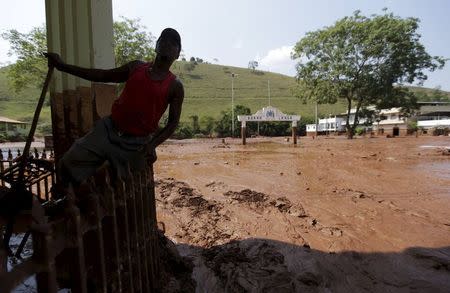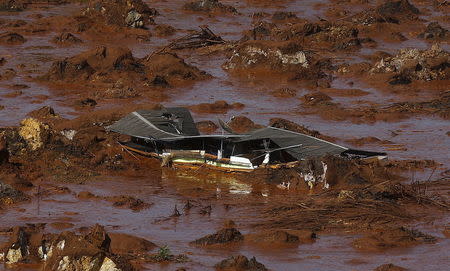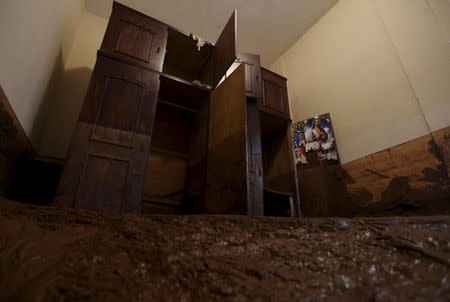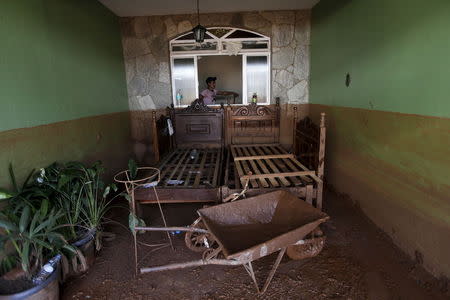Third possible death being probed near burst Brazil dams
By Stephen Eisenhammer MARIANA, Brazil (Reuters) - Brazilian authorities on Sunday were investigating a third possible death caused by a massive mudflow and flooding that swamped towns near an iron ore mine in the southeastern state of Minas Gerais. As many as 28 people are still missing after two dams burst on Thursday, triggering the disaster and prompting a rescue and salvage operation involving about 500 people, many of whom are still searching, with the help of dogs and special equipment, for victims along the floodplain downstream from the dams. After confirming a second death caused by the tragedy early Sunday, response teams midday said they had found a third body, but were still working to retrieve it. They had not yet confirmed a cause of death or whether the corpse belonged to one of those still reported missing. The torrent, carrying water and mud stained with mineral waste from the mine, flooded areas as far as 100 km (60 miles) from the rupture. While the surge has receded, authorities expect the residue in the mainstream of the Rio Doce to reach the neighboring state of Espirito Santo by Tuesday. Neither authorities nor mine operator Samarco - a joint venture between the world's largest mining company, BHP Billiton Ltd , and the biggest iron ore miner, Vale SA - have determined a cause for the rupture. Official response to the disaster has so far focused on recovery. But residents, regulators, environmentalists and others across Brazil have begun questioning oversight at the mine, pointing to broader concerns about the safety and sustainability of mining, one of Brazil's biggest industries and a major source of export revenue. On Saturday, the Estado de S. Paulo newspaper reported that a study commissioned by the state government in Minas Gerais in 2013 had warned that the dams that burst could be vulnerable. On Sunday, helicopters and vehicles went in and out of an operational base set up near the mine for recovery efforts that have been slowed by heavy rains and mist. Though finding survivors is growing less likely, officials said they did not rule it out. Of the 28 people listed as missing, 13 were mine workers. Authorities said 580 people have been displaced and are taking shelter in hotels or with family and friends. Samarco is paying for accommodations and relocation. Government officials, however, have chided the company for lax communication on how long the displacements might last and what solutions it will propose for damaged and destroyed homes. "They haven't said until when we can stay or where we'll go afterwards," said Gilberto Perreira da Silva, standing outside a hotel where he is being lodged in the old center of Mariana, the city closest to the mine. Da Silva's village was washed away by the waters. Cristiane Temporao, a Samarco employee tending to those at the hotel, asked for patience while the company determines the best course. "When we settle on a plan it's got to be a good one," she said. On Sunday, BHP said in a statement it was providing Samarco "with all the assistance necessary" and that Andrew Mackenzie, the Australian miner's chief executive officer, is traveling to Brazil to meet with local executives, authorities and better determine their needs. Vale has referred all queries about the incident to Samarco. The governor of Minas Gerais, Fernando Pimentel said in a briefing on Sunday after flying over the region that the government would begin studying what regulatory measures may have fallen short. Though dams in the state undergo reviews by independent inspectors, more would be needed to ensure similar disasters do not happen again. "Obviously, this wasn't enough," he said. "We have to learn the lessons of this accident and improve the emergency plans." Pimentel, however, sought to dispel notions that environmental licensing in the state could be to blame. "There was no failure on this front," he said. Duarte Junior, the mayor of Mariana, was hospitalized early on Sunday for what his wife said could be a heart attack after nearly three days of emergency work. The Samarco mine is located in the so-called iron quadrangle, one of the most heavily mined regions in the world. At a time when iron ore prices have collapsed compared with historic highs in recent years, cleanup and other costs related to the disaster, including regulatory penalties and any litigation Samarco may face, are expected to be high. (Writing by Paulo Prada; Editing by Andrew Bolton, Alan Crosby and Leslie Adler)






